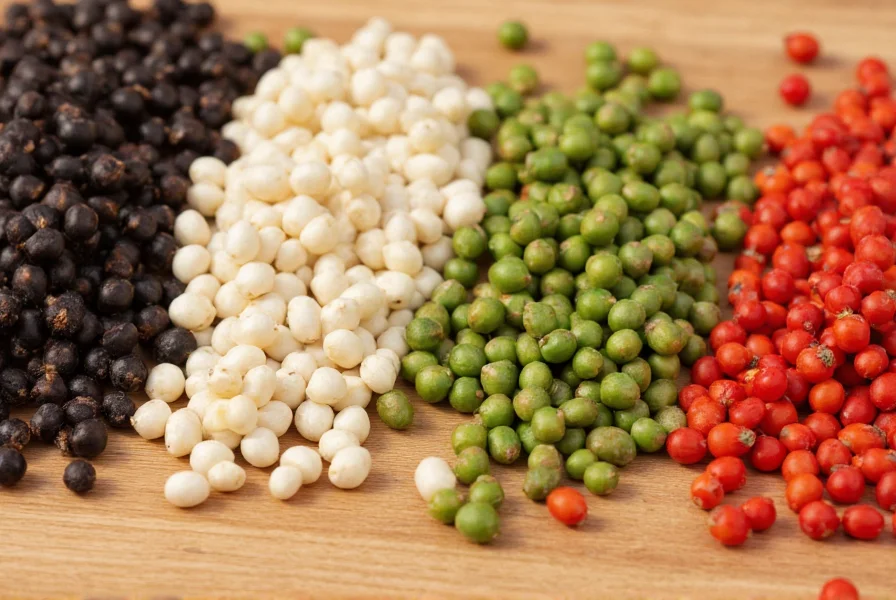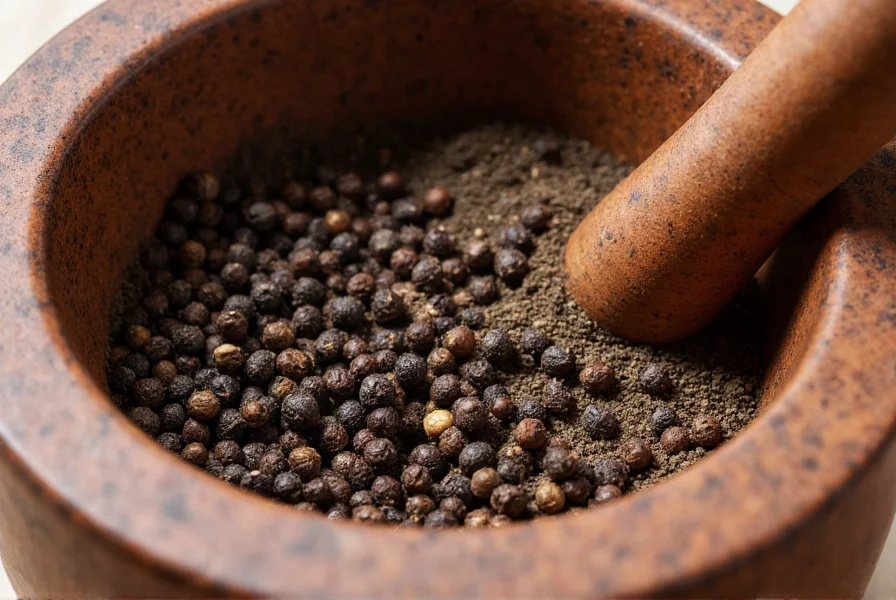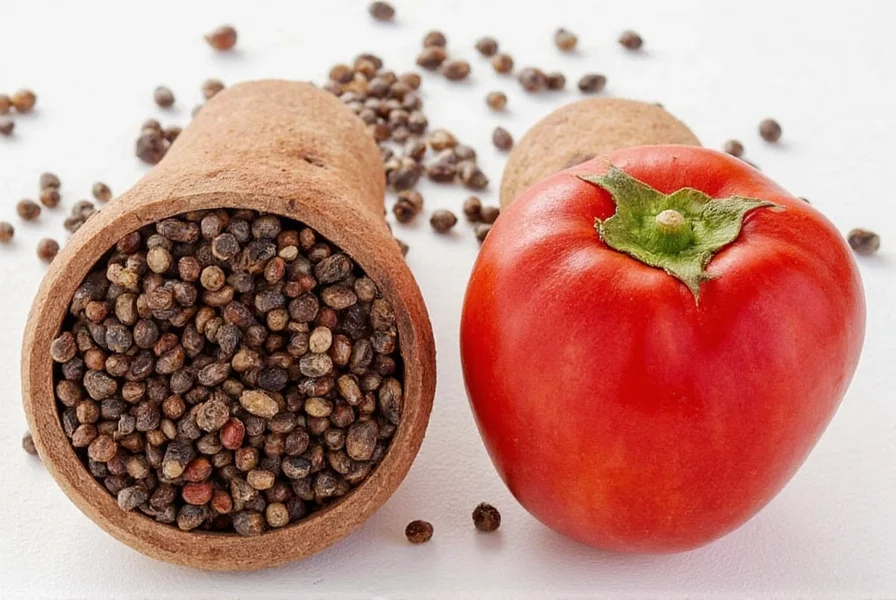Understanding the distinction between pepper vs peppercorn clears up one of the most persistent culinary confusions. Many home cooks and even professional chefs use these terms interchangeably without realizing the precise relationship between them. This article provides definitive clarification about these commonly misunderstood spice terms.
What Exactly Are Peppercorns?
Peppercorns are the fruit of Piper nigrum, a flowering vine native to South India. These small, round berries grow in clusters and undergo different processing methods that create the various peppercorn types available today. When you see whole peppercorns in a grinder or recipe, you're looking at the unprocessed or minimally processed fruit of this specific plant.

How “Pepper” Relates to Peppercorns
The term “pepper” most accurately refers to the ground form of peppercorns. When recipes call for “pepper,” they typically mean freshly ground peppercorns. However, culinary professionals often use “pepper” as shorthand for the entire category, whether whole or ground.
This linguistic shorthand creates confusion because other plants—completely unrelated to Piper nigrum—also carry “pepper” in their common names. Bell peppers, chili peppers, and paprika all belong to the Solanaceae family (nightshades), while true peppercorns come from the Piperaceae family.
Common Misconceptions About Pepper Terminology
Many people mistakenly believe “pepper” refers only to the ground spice while “peppercorn” describes something entirely different. In reality, they represent different forms of the same botanical product. The critical distinction lies between:
- True pepper/peppercorns: From Piper nigrum (black, white, green, red peppercorns)
- Other “peppers”: From nightshade family (bell peppers, jalapeños, cayenne, etc.)
Understanding this difference between pepper vs peppercorn versus other pepper-named plants prevents recipe errors and enhances culinary knowledge.
Types of True Peppercorns and Their Characteristics
| Type | Processing Method | Flavor Profile | Best Culinary Uses |
|---|---|---|---|
| Black Peppercorns | Picked unripe, sun-dried until wrinkled | Sharp, pungent, complex heat | All-purpose seasoning, steak rubs, sauces |
| White Peppercorns | Ripe berries soaked to remove outer layer | Milder, earthier, less complex | Light-colored sauces, potato dishes, European cuisine |
| Green Peppercorns | Unripe berries preserved in brine or freeze-dried | Fresh, floral, subtle heat | Asian cuisine, creamy sauces, seafood dishes |
| Red Peppercorns | Ripe berries preserved in brine or vacuum-sealed | Fruity, sweet, mild heat | Garnishes, fruit-based sauces, specialty dishes |
Practical Implications for Home Cooks
Knowing the difference between pepper and peppercorn matters for several practical reasons:
- Flavor intensity: Whole peppercorns retain essential oils better than pre-ground pepper, delivering superior flavor
- Recipe accuracy: Some recipes specifically call for whole peppercorns (like pickling) versus freshly ground pepper
- Storage considerations: Whole peppercorns stay fresh for 2-3 years when stored properly, while ground pepper loses potency within 4-6 months
- Culinary precision: Understanding that “pepper” in recipes usually means black pepper unless specified otherwise
For optimal flavor, always grind peppercorns immediately before use. The volatile oils that create pepper's distinctive aroma and heat dissipate quickly after grinding.

Why the Confusion Persists
The historical misapplication of “pepper” to New World chilies stems from early European explorers. When Spanish explorers encountered chili peppers in the Americas, they noted their pungency resembled that of Asian black pepper, so they applied the familiar term “pepper” to these completely unrelated plants.
This linguistic accident has persisted for centuries, creating ongoing confusion between pepper spice vs peppercorn and other pepper varieties. Modern culinary professionals increasingly use precise terminology to distinguish between these botanical families.
Conclusion: Clarifying Pepper Terminology
The distinction between pepper and peppercorn is straightforward once you understand they represent different forms of the same spice. Peppercorns are the whole berries; pepper typically refers to the ground form. The real confusion arises from unrelated plants that borrowed the “pepper” name due to superficial similarities in pungency.
By recognizing this difference between pepper and peppercorn, you'll make more informed choices in the kitchen, understand recipes more accurately, and appreciate the rich history behind these essential culinary ingredients.
Frequently Asked Questions
Are peppercorns and black pepper the same thing?
Yes, black peppercorns are the unprocessed berries of the Piper nigrum plant, while black pepper refers to the ground form of these same berries. They are different forms of the exact same spice.
Can I substitute ground pepper for whole peppercorns in recipes?
In most cases, yes, but with flavor considerations. As a general rule, 1/4 teaspoon of freshly ground pepper equals approximately 1/2 teaspoon of coarsely crushed peppercorns or 1 teaspoon of whole peppercorns. For best results, especially in pickling or spice blends, follow the recipe's specified form.
Why do some recipes specify whole peppercorns instead of ground pepper?
Recipes call for whole peppercorns when a milder, more gradual release of flavor is desired (like in soups or pickling brines), or when the visual presence of peppercorns is part of the dish's presentation. Whole peppercorns also provide different textural elements compared to ground pepper.
Do different colored peppercorns come from different plants?
No, black, white, green, and red peppercorns all come from the same Piper nigrum plant. The color differences result from harvesting at different ripeness stages and varying processing methods, not from different plant species.
Is pink pepper the same as regular peppercorn?
No, pink pepper comes from a completely different plant (Schinus molle or Schinus terebinthifolius), native to South America. Despite the name, it's unrelated to true peppercorns and belongs to the cashew family. Some people experience allergic reactions to pink pepper if they're sensitive to cashews.











 浙公网安备
33010002000092号
浙公网安备
33010002000092号 浙B2-20120091-4
浙B2-20120091-4